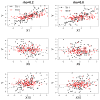Sequential advantage selection for optimal treatment regime
- PMID: 27326312
- PMCID: PMC4912022
- DOI: 10.1214/15-AOAS849
Sequential advantage selection for optimal treatment regime
Abstract
Variable selection for optimal treatment regime in a clinical trial or an observational study is getting more attention. Most existing variable selection techniques focused on selecting variables that are important for prediction, therefore some variables that are poor in prediction but are critical for decision-making may be ignored. A qualitative interaction of a variable with treatment arises when treatment effect changes direction as the value of this variable varies. The qualitative interaction indicates the importance of this variable for decision-making. Gunter, Zhu and Murphy (2011) proposed S-score which characterizes the magnitude of qualitative interaction of each variable with treatment individually. In this article, we developed a sequential advantage selection method based on the modified S-score. Our method selects qualitatively interacted variables sequentially, and hence excludes marginally important but jointly unimportant variables or vice versa. The optimal treatment regime based on variables selected via joint model is more comprehensive and reliable. With the proposed stopping criteria, our method can handle a large amount of covariates even if sample size is small. Simulation results show our method performs well in practical settings. We further applied our method to data from a clinical trial for depression.
Keywords: optimal treatment regime; qualitative interaction; variable selection.
Figures





References
-
- Fava M, Rush AJ, Trivedi MH, Nierenberg AA, Thase ME, Sackeim HA, Quitkin FM, Wisniewski S, Lavori PW, Rosenbaum JF, et al. Background and rationale for the Sequenced Treatment Alternatives to Relieve Depression (STAR* D) study. Psychiatric Clinics of North America. 2003;26:457–494. - PubMed
-
- Gail M, Simon R. Testing for qualitative interactions between treatment effects and patient subsets. Biometrics. 1985:361–372. - PubMed
Grants and funding
LinkOut - more resources
Full Text Sources
Other Literature Sources
